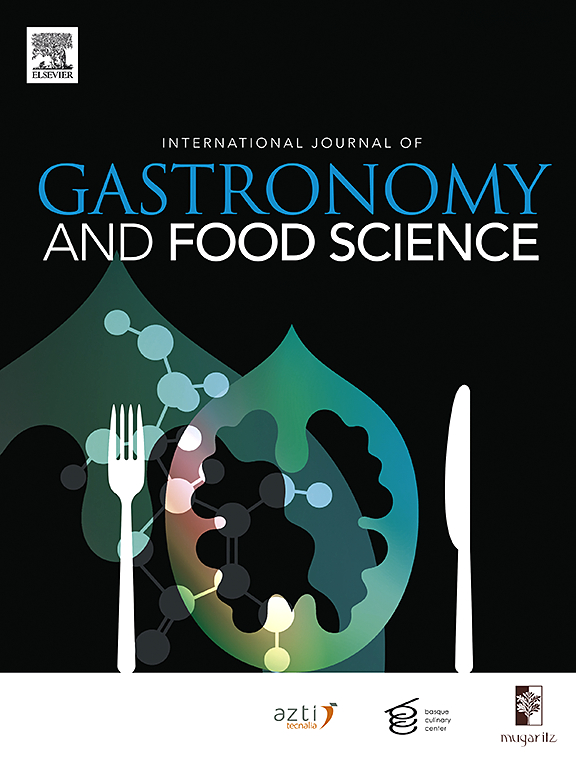日本女护士的特点和饮食质量与她们的食物摄入模式:日本护士健康研究
IF 3.6
2区 农林科学
Q2 FOOD SCIENCE & TECHNOLOGY
International Journal of Gastronomy and Food Science
Pub Date : 2025-07-01
DOI:10.1016/j.ijgfs.2025.101236
引用次数: 0
摘要
日本女性是世界上预期寿命最长的女性。了解他们饮食背后的背景因素可能为改善全球健康状况提供有用的信息。本研究旨在调查日本女护士的特点和饮食质量与她们的食物摄入模式的关系。本横断面研究包括11164名日本女护士。参与者完成了一份包含98个项目的半定量食物频率问卷,并提供了他们的人口特征信息。基于能量贡献,使用潜类分析对参与者的食物摄入模式进行分类,并使用替代健康饮食指数对饮食质量进行评分,从0(最差)到110(最好)。他们确定了四种模式:“第一类:方便和高度加工的食品”,“第二类:传统日本食品”,“第三类:蔬菜/水果为主”,以及“第四类:海鲜和高零食”。第二组的替代健康饮食指数得分最高(73分),而第一组的得分最低(61分)。年轻护士、夜班护士、注册护士/执业护士和吸烟者中第1类的患病率明显较高;第2级的年长护士,即从事公共卫生或助产工作而不上夜班的护士;在有子女的公共卫生护士/助产士中适用第3级;第4类别的注册/持牌执业护士、吸烟者、夜班工作者及无子女人士。日本女护士的饮食质量很高,特别是那些吃传统日本饮食的护士。年轻护士、吸烟或上夜班的护士更有可能饮食质量较差。本文章由计算机程序翻译,如有差异,请以英文原文为准。
Japanese female nurses' characteristics and diet quality associated with their food intake patterns: The Japan Nurses’ Health Study
Japanese women have the longest life expectancy of any population of women in the world. Insights regarding the background factors behind their diets may provide helpful information for improving health globally. The present study aimed to examine Japanese female nurses' characteristics and the diet quality associated with their food intake patterns. This cross-sectional study included 11,164 female Japanese nurses. Participants completed a 98-item semi-quantitative food frequency questionnaire and provided information about their demographic characteristics. Latent class analysis was used to classify participants’ food intake patterns on the basis of energy contribution, and the Alternative Healthy Eating Index was used to score diet quality from 0 (worst) to 110 (best). Four patterns were identified: “Class 1: Convenient and highly processed food,” “Class 2: Traditional Japanese food,” “Class 3: Vegetable/fruit-oriented,” and “Class 4: Seafood and high snacking.” Alternative Healthy Eating Index scores were best (73) in Class 2 and worst (61) in Class 1. Prevalence ratios were significantly higher for Class 1 among younger nurses, those working night shifts, registered/licensed practical nurses and smokers; for Class 2 among older nurses, those working in public health or midwifery, and not working night shifts; for Class 3 among public health nurses/midwifes with children; and for Class 4 among registered/licensed practical nurses, smokers, those working night shifts, and those without children. Diet quality among Japanese female nurses was high, especially for those who ate a traditional Japanese diet. Younger nurses and those who smoked or worked night shifts were more likely to have a poorer quality diet.
求助全文
通过发布文献求助,成功后即可免费获取论文全文。
去求助
来源期刊

International Journal of Gastronomy and Food Science
Social Sciences-Cultural Studies
CiteScore
5.30
自引率
10.50%
发文量
170
审稿时长
45 days
期刊介绍:
International Journal of Gastronomy and Food Science is a peer-reviewed journal that explicitly focuses on the interface of food science and gastronomy. Articles focusing only on food science will not be considered. This journal equally encourages both scientists and chefs to publish original scientific papers, review articles and original culinary works. We seek articles with clear evidence of this interaction. From a scientific perspective, this publication aims to become the home for research from the whole community of food science and gastronomy.
IJGFS explores all aspects related to the growing field of the interaction of gastronomy and food science, in areas such as food chemistry, food technology and culinary techniques, food microbiology, genetics, sensory science, neuroscience, psychology, culinary concepts, culinary trends, and gastronomic experience (all the elements that contribute to the appreciation and enjoyment of the meal. Also relevant is research on science-based educational programs in gastronomy, anthropology, gastronomic history and food sociology. All these areas of knowledge are crucial to gastronomy, as they contribute to a better understanding of this broad term and its practical implications for science and society.
 求助内容:
求助内容: 应助结果提醒方式:
应助结果提醒方式:


